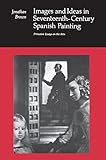Images and Ideas in Seventeenth-Century Spanish Painting / Jonathan Brown.
Material type: TextSeries: Princeton Essays on the Arts ; 1Publisher: Princeton, NJ : Princeton University Press, [2022]Copyright date: ©1979Description: 1 online resource (201 p.)Content type:
TextSeries: Princeton Essays on the Arts ; 1Publisher: Princeton, NJ : Princeton University Press, [2022]Copyright date: ©1979Description: 1 online resource (201 p.)Content type: - 9780691241920
- Art and society -- Spain
- Catholic Church in art
- Painting, Baroque -- Spain
- Painting, Spanish
- ART / History / General
- Abbasid Caliphate
- Alonso Berruguete
- Altarpiece
- Angelo Nardi (painter)
- Antonio Mohedano
- Antonio de Pereda
- Apollo and Daphne (Bernini)
- Art history
- Arte
- Baroque painting
- Bartolomé de las Casas
- Benito Arias Montano
- Caravaggio
- Carthusians
- Castile (historical region)
- Catholic Monarchs
- Chapel of St. Jerome
- Charles V, Holy Roman Emperor
- Church Fathers
- Cimabue
- Classical mythology
- Comedia (Spanish play)
- Council of Trent
- Counter-Reformation
- Court painter
- Crown of Castile
- Diego Velázquez
- Discalced Carmelites
- Don Juan Tenorio
- El Greco
- Erudition
- Fernando de Herrera
- Francisco Pacheco
- Francisco de Borja
- Francisco de Rioja
- Friar
- Garcilaso de la Vega (poet)
- Gaspar Melchor de Jovellanos
- Genre painting
- Georges de La Tour
- Gian Lorenzo Bernini
- Giovanni Baglione
- Giovanni Battista Crescenzi
- Gustave Courbet
- Hieronymites
- Iconography
- Ignatius of Loyola
- Illusionism (art)
- Impressionism
- In Ictu Oculi
- Jan van Eyck
- Juan de Mal Lara
- Juan de las Roelas
- Jusepe de Ribera
- Las Hilanderas (Velázquez)
- Las Meninas
- Literature
- Marsilio Ficino
- Masaccio
- Matthew 25
- Military order (monastic society)
- Museo del Prado
- Order of Santiago
- Our Lady of Guadalupe
- Painting
- Parmigianino
- Pietro da Cortona
- Poetic diction
- Poetry
- Protestantism
- Putto
- Real Academia de Bellas Artes de San Fernando
- Real Academia de la Historia
- Religious art
- Renaissance art
- Sacristy
- Saint Christopher
- Santa Hermandad
- Santa Trinita
- Scholasticism
- Seville Cathedral
- Shakespeare's sonnets
- Society of Jesus
- Spain
- Spanish Empire
- Spanish Golden Age
- Spanish art
- Spanish nobility
- Susanna (Book of Daniel)
- Teresa of Ávila
- The Art of Painting
- The Battle of Lepanto (Luna painting)
- The Dissertation
- The Poetaster
- The Return of the Prodigal Son (Rembrandt)
- Theory of painting
- Tintoretto
- Titian
- University of Salamanca
- Ut pictura poesis
- 759.6
- ND806 .B76
- online - DeGruyter
| Item type | Current library | Call number | URL | Status | Notes | Barcode | |
|---|---|---|---|---|---|---|---|
 eBook
eBook
|
Biblioteca "Angelicum" Pont. Univ. S.Tommaso d'Aquino Nuvola online | online - DeGruyter (Browse shelf(Opens below)) | Online access | Not for loan (Accesso limitato) | Accesso per gli utenti autorizzati / Access for authorized users | (dgr)9780691241920 |
Browsing Biblioteca "Angelicum" Pont. Univ. S.Tommaso d'Aquino shelves, Shelving location: Nuvola online Close shelf browser (Hides shelf browser)

|

|

|

|

|

|

|
||
| online - DeGruyter Studies in Greek Philosophy, Volume I : The Presocratics / | online - DeGruyter Studies in Greek Philosophy, Volume II : Socrates, Plato, and Their Tradition / | online - DeGruyter Local Religion in Sixteenth-Century Spain / | online - DeGruyter Images and Ideas in Seventeenth-Century Spanish Painting / | online - DeGruyter Kierkegaard Anthology / | online - DeGruyter Daidalos and the Origins of Greek Art / | online - DeGruyter Marketing Modernism in Fin-de-Siècle Europe / |
Frontmatter -- PREFACE -- CONTENTS -- LIST OF ILLUSTRATIONS -- PHOTOGRAPH CREDITS -- INTRODUCTION: OBSERVATIONS ON THE HISTORIOGRAPHY OF SEVENTEENTH-CENTURY SPANISH PAINTING -- PART I: THEORY AND ART IN THE ACADEMY OF FRANCISCO PACHECO -- 1. A Community of Scholars -- 2. El Arte de la Pintura as an Academic Document -- 3. Theory into Practice: The Arts and the Academy -- PART II: PAINTERS AND PROGRAMS -- 4. On the Meaning of Las Meninas -- 5. Zurbaran's Paintings in the Sacristy of the Monastery of Guadalupe -- 6. Hieroglyphs of Death and Salvation: The Decoration of the Church of the Hermandad de la Caridad, Seville -- EPILOGUE -- BIBLIOGRAPHY -- INDEX
restricted access online access with authorization star
http://purl.org/coar/access_right/c_16ec
Art historians have often minimized the variety and complexity of seventeenth-century Spanish painting by concentrating on individual artists and their works and by stressing discovery of new information rather than interpretation. As a consequence, the painter emerges in isolation from the forces that shaped his work. Jonathan Brown offers another approach to the subject by relating important Spanish Baroque paintings and painters to their cultural milieu.A critical survey of the historiography of seventeenth-century Spanish painting introduces this two-part collection of essays. Part One provides the most detailed study to date of the artistic-literary academy of Francisco Pacheco, and Part Two contains original studies of four major painters and their works: Las Meninas of Velázquez, Zurbarán's decoration of the sacristy at Guadalupe, and the work by Murillo and Valdés Leal for the Brotherhood of Charity, Seville. The essays are unified by the author's intention to show how the artists interacted with and responded to the prevailing social, theological, and historical currents of the time. While this contextual approach is not uncommon in the study of European art, it is newly applied here to restore some of the diversity and substance that Spanish Baroque painting originally possessed.
Mode of access: Internet via World Wide Web.
In English.
Description based on online resource; title from PDF title page (publisher's Web site, viewed 02. Mrz 2022)


